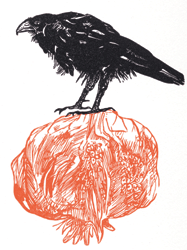
Bridge Street Cemetery Northampton Architecture Historic Markers 
|


The Gehenna Press
In 1955, the Gehenna Press opened its doors at 51 Clark Avenue, its presence announced for many years by an elegant slate sign whose lettering is reproduced in the title for this marker. From Clark Avenue, then from Lurley, Devon, England, and, after 1983, from the founder’s home in the Northampton village of Leeds, would emerge more than 100 books, masterworks of art, design, and production that contribute richly to our political, social, artistic and literary history.
 |
| Photo by Stephen Petegorsky |
Leonard Baskin (1922-2000), sculptor and graphic artist, founded the press in 1942, while a student of fine art at Yale. Inspired by poet and bookmaker William Blake, Baskin issued a selection of his own poems as the first book from his new press, the name for which he took from a line in Milton’s Paradise Lost, “And black Gehenna call’d, the type of Hell.”
Over the next six decades, the Gehenna Press worked to the highest publishing standard, combined significant text with meaningful images and estimable design, materials, printing, and binding. Among the projects that issued from the press are the Gehenna Essays in Art, a series of commissioned pieces in art history, and Gehenna Tracts, reprints of landmark social texts. Gehenna brought out the first U.S. printing of Wilfred Owen’s poems, with drawings by Ben Shahn, and The Book of Plains Indians, a collaboration in words and art between Baskin and Fritz Scholder. It gave us new translations of works by Aeschylus, Euripides, and Goethe, among others. Ted Hughes, Anthony Hecht, Anne Halley, and James Baldwin contributed poetic accompaniments to Baskin artwork for yet other press creations.
 |
Contents Historic Northampton.